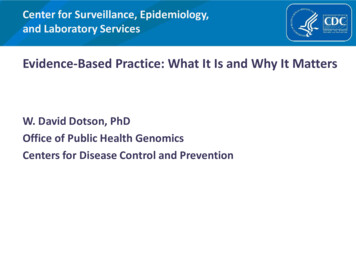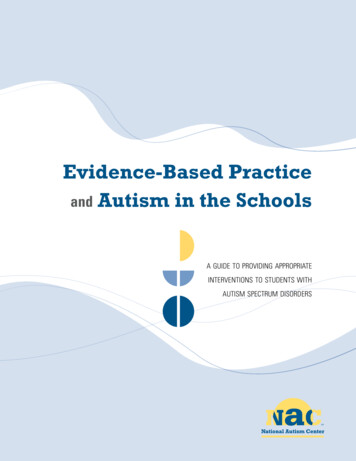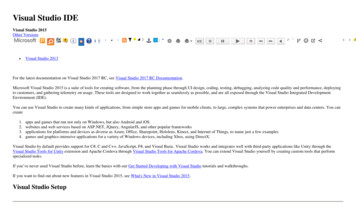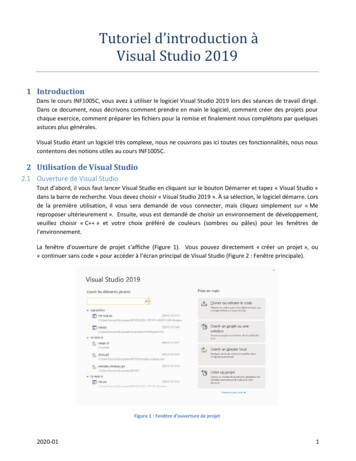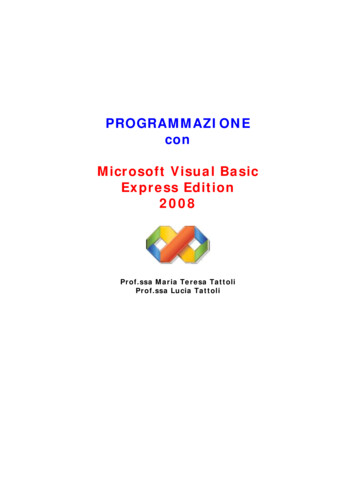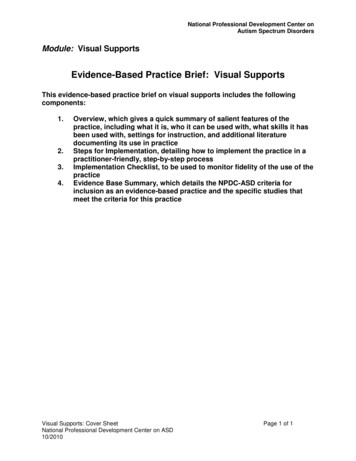
Transcription
National Professional Development Center onAutism Spectrum DisordersModule: Visual SupportsEvidence-Based Practice Brief: Visual SupportsThis evidence-based practice brief on visual supports includes the followingcomponents:1.2.3.4.Overview, which gives a quick summary of salient features of thepractice, including what it is, who it can be used with, what skills it hasbeen used with, settings for instruction, and additional literaturedocumenting its use in practiceSteps for Implementation, detailing how to implement the practice in apractitioner-friendly, step-by-step processImplementation Checklist, to be used to monitor fidelity of the use of thepracticeEvidence Base Summary, which details the NPDC-ASD criteria forinclusion as an evidence-based practice and the specific studies thatmeet the criteria for this practiceVisual Supports: Cover SheetNational Professional Development Center on ASD10/2010Page 1 of 1
National Professional Development Center onAutism Spectrum DisordersModule: Visual SupportsOverview of Visual SupportsHume, K. (2008). Overview of visual supports. Chapel Hill, NC: National ProfessionalDevelopment Center on Autism Spectrum Disorders, Frank Porter Graham ChildDevelopment Institute, The University of North Carolina.Visual supports are any tool presented visually that supports an individual as he or she movesthrough the day. Visual supports might include, but are not limited to, pictures, written words,objects within the environment, arrangement of the environment or visual boundaries,schedules, maps, labels, organization systems, timelines, and scripts. They are used acrosssettings to support individuals with ASD (National Research Council, 2001).EvidenceVisual supports meet the evidence-based practice criteria within the early childhood,elementary, and middle school age groups.With what ages are visual supports effective?Visual supports can be implemented with individuals across the age range, beginning inpreschool and extending through middle school age. Effective visual supports in early childhoodsettings include visual schedules to increase task engagement, visual scripts to encouragesocial interaction, and picture cues to support play skill development (Krantz & McClannahan,1998; Massey & Wheeler, 2000; Morrison, Sainato, BenChaaban, & Endo, 2002). In elementaryand middle school, visual supports such as schedules and picture cues have proven effective inreducing transition time, increasing on-task behavior, and in completing self-help in the home(Bryan & Gast, 2000; Dettmer, Simpson, Myles, & Ganz, 2000; MacDuff, Krantz, &McClannahan, 1993).What skills or intervention goals can be addressed by visual supports?Visual supports target a number of adaptive behavior skills, including task engagement,independent performance, transitions across activities, and increasing response chain length.Visual supports have also proven effective in increasing skills across curriculum areas, includingthe demonstration of play skills, social interaction skills, and social initiation. In addition, visualsupports have been beneficial in reducing self-injurious behavior.In what settings can visual supports be effectively used?Visual supports have been used effectively in classroom settings and home settings. Visualsupports are intended to be used as one component of comprehensive programming forindividuals with ASD.Visual Supports: OverviewNational Professional Development Center on ASD10/2010Page 1 of 3
National Professional Development Center onAutism Spectrum DisordersModule: Visual SupportsEvidence BaseThe studies cited in this section provide the basis upon which this practice was determined tomeet the NPDC on ASD’s criteria as an evidence-based practice. This list is not exhaustive andother quality studies may exist but were not found in our search.PreschoolDauphin, M., Kinney, E. M., & Stromer, R. (2004). Using video enhanced activity schedules andmatrix training to teach sociodramatic play to a child with autism. Journal of PositiveBehavior Interventions, 6, 238–250.Johnston, S., Nelson, C., Evans, J., & Palazolo, K. (2003). The use of visual supports inteaching young children with autism spectrum disorder to initiate interactions. AAC:Augmentative & Alternative Communication, 19, 86-104.Krantz, P. J., & McClannahan, L. E. (1998). Social interaction skills for children with autism: Ascript-fading procedure for beginning readers. Journal of Applied Behavior Analysis, 31,191-202.Massey, G., & Wheeler, J. (2000). Acquisition and generalization of activity schedules and theireffects on task engagement in a young child with autism in an inclusive preschoolclassroom. Education and Training in Mental Retardation and DevelopmentalDisabilities, 35, 326-335.Morrison, R., Sainato, D., BenChaaban, D., & Endo, S. (2002). Increasing play skills of childrenwith autism using activity schedules and correspondence training. Journal of EarlyIntervention, 25, 58-72.Elementary and Middle School AgeBryan, L., & Gast, D. (2000). Teaching on-task and on-schedule behaviors to high functioningchildren with autism via picture activity schedules. Journal of Autism and DevelopmentalDisorders, 30, 553-567.Dettmer, S., Simpson, R., Myles, B., & Ganz, J. (2000). The use of visual supports to facilitatetransitions of students with autism. Focus on Autism and Other DevelopmentalDisabilities, 15, 163-170.Krantz, P., MacDuff, M., & McClannahan, L. (1993). Programming participation in familyactivities for children with autism: Parent's use photographic activity schedules. Journalof Applied Behavior Analysis, 26, 137-138.MacDuff, G., Krantz, P., & McClannahan, L. (1993). Teaching children with autism to usephotographic activity schedules: Maintenance and generalization of complex responsechains. Journal of Applied Behavior Analysis, 26, 89-97.O'Reilly, M., Sigafoos, J., Lancioni, G., Edrisinha, C., & Andrews, A. (2005). AnVisual Supports: OverviewNational Professional Development Center on ASD10/2010Page 2 of 3
National Professional Development Center onAutism Spectrum DisordersModule: Visual Supportsexamination of the effects of a classroom activity schedule on levels of self-injury andengagement for a child with severe autism. Journal of Autism & DevelopmentalDisorders, 35, 305-311.Pierce, K., & Schreibman, L. (1994). Teaching daily living skills to children with autism inunsupervised settings through pictorial self-management. Journal of Applied BehaviorAnalysis, 27, 471-481.Schmit, J., Alper, S., Raschke, D., & Ryndak, D. (2000). Effects of using a photographic cueingpackage during routine school transitions with a child who has autism. MentalRetardation, 38, 131–137.Vaughn, B., & Horner, H. (1995). Effects of concrete versus verbal choice systems on problembehavior. Augmentative and Alternative Communication, 11, 89-92.Selected Additional ReferencesCohen, M. J., & Sloan, D. L. (2007). Visual supports for people with autism: A guide for parentsand professionals. Bethesda, MD: Woodbine House.Mesibov, G., Shea, V., & Schopler, E. (2005). The TEACCH approach to autism spectrumdisorders. New York: Plenum Press.National Research Council (2001). Educating children with autism. Washington, DC: NationalAcademy Press.Quill, K. A. (1997). Instructional considerations for young children with autism: The rationale forvisually cued instruction. Journal of Autism and Other Developmental Disorders, 27(6),697-714.Tissot, C., & Evans, R. (2003). Visual teaching strategies for children with autism. Early ChildDevelopment and Care, 174(4), 425-433.Visual Supports: OverviewNational Professional Development Center on ASD10/2010Page 3 of 3
National Professional Development Center onAutism Spectrum DisordersModule: Visual SupportsEvidence Base for Visual SupportsThe National Professional Development Center on ASD has adopted the following definition ofevidence-based practices.To be considered an evidence-based practice for individuals with ASD, efficacy must beestablished through peer-reviewed research in scientific journals using:randomized or quasi-experimental design studies. Two high quality experimental orquasi-experimental group design studies,single-subject design studies. Three different investigators or research groups musthave conducted five high quality single subject design studies, orcombination of evidence. One high quality randomized or quasi-experimental groupdesign study and three high quality single subject design studies conducted by atleast three different investigators or research groups (across the group and singlesubject design studies).High quality randomized or quasi experimental design studies do not have critical design flawsthat create confounds to the studies, and design features allow readers/consumers to rule outcompeting hypotheses for study findings. High quality in single subject design studies isreflected by a) the absence of critical design flaws that create confounds and b) thedemonstration of experimental control at least three times in each study.Horner, R., Carr, E., Halle, J., McGee, G., Odom, S., & Wolery, M. (2005). The use of singlesubject research to identify evidence-based practice in special education. ExceptionalChildren, 71, 165-180.Nathan, P., & Gorman, J. M. (2002). A guide to treatments that work. NY: OxfordUniversity Press.Odom, S. L., Brantlinger, E., Gersten, R., Horner, R. D., Thompson, B., & Harris, K. (2004).Quality indicators for research in special education and guidelines for evidence-basedpractices: Executive summary. Arlington, VA: Council for Exceptional Children Divisionfor Research.Rogers, S. J., & Vismara, L. A. (2008). Evidence based comprehensive treatments for earlyautism. Journal of Clinical Child and Adolescent Psychology, 37(1), 8-38.Visual Supports: Evidence BaseNational Professional Development Center on ASD10/2010Page 1 of 3
National Professional Development Center onAutism Spectrum DisordersModule: Visual SupportsUsing these criteria, the empirical studies referenced below provide documentation forsupporting peer mediated instruction and intervention as an evidence-based practice. This list isnot exhaustive; other quality studies may exist that were not included.PreschoolDauphin, M., Kinney, E. M., & Stromer, R. (2004). Using video enhanced activity schedules andmatrix training to teach sociodramatic play to a child with autism. Journal of PositiveBehavior Interventions, 6, 238–250.Johnston, S., Nelson, C., Evans, J., & Palazolo, K. (2003). The use of visual supports inteaching young children with autism spectrum disorder to initiate interactions. AAC:Augmentative & Alternative Communication, 19, 86-104.Krantz, P. J., & McClannahan, L. E. (1998). Social interaction skills for children with autism: Ascript-fading procedure for beginning readers. Journal of Applied Behavior Analysis, 31,191-202.Massey, G., & Wheeler, J. (2000). Acquisition and generalization of activity schedules and theireffects on task engagement in a young child with autism in an inclusive preschoolclassroom. Education and Training in Mental Retardation and DevelopmentalDisabilities, 35, 326-335.Morrison, R., Sainato, D., BenChaaban, D., & Endo, S. (2002). Increasing play skills of childrenwith autism using activity schedules and correspondence training. Journal of EarlyIntervention, 25, 58-72.Elementary and Middle SchoolBryan, L., & Gast, D. (2000). Teaching on-task and on-schedule behaviors to high functioningchildren with autism via picture activity schedules. Journal of Autism and DevelopmentalDisorders, 30, 553-567.Dettmer, S., Simpson, R., Myles, B., & Ganz, J. (2000). The use of visual supports to facilitatetransitions of students with autism. Focus on Autism and Other DevelopmentalDisabilities, 15, 163-170.Krantz, P., MacDuff, M., & McClannahan, L. (1993). Programming participation in familyactivities for children with autism: Parent's use photographic activity schedules. Journalof Applied Behavior Analysis, 26, 137-138.Elementary and Middle SchoolVisual Supports: Evidence BaseNational Professional Development Center on ASD10/2010Page 2 of 3
National Professional Development Center onAutism Spectrum DisordersModule: Visual SupportsMacDuff, G., Krantz, P., & McClannahan, L. (1993). Teaching children with autism to usephotographic activity schedules: Maintenance and generalization of complex responsechains. Journal of Applied Behavior Analysis, 26, 89-97.O'Reilly, M., Sigafoos, J., Lancioni, G., Edrisinha, C., & Andrews, A. (2005). Anexamination of the effects of a classroom activity schedule on levels of self-injury andengagement for a child with severe autism. Journal of Autism & DevelopmentalDisorders, 35, 305-311.Pierce, K., & Schreibman, L. (1994). Teaching daily living skills to children with autism inunsupervised settings through pictorial self-management. Journal of Applied BehaviorAnalysis, 27, 471-481.Schmit, J., Alper, S., Raschke, D., & Ryndak, D. (2000). Effects of using a photographic cueingpackage during routine school transitions with a child who has autism. MentalRetardation, 38, 131–137.Vaughn, B., & Horner, H. (1995). Effects of concrete versus verbal choice systems on problembehavior. Augmentative and Alternative Communication, 11, 89-92.Visual Supports: Evidence BaseNational Professional Development Center on ASD10/2010Page 3 of 3
National Professional Development Center onAutism Spectrum DisordersModule: Visual SupportsSteps for Implementation: Visual SupportsHume, K., & Smith, S. (2009). Steps for implementation: Visual supports. Chapel Hill, NC: TheNational Professional Development Center on Autism Spectrum Disorders, Frank PorterGraham Child Development Institute, The University of North Carolina.This document includes steps for implementation for several visual supports including labels,locators, and visuals across the curriculum. To access step-by-step instructions for visualschedules or visual boundaries, please see the related Steps for Implementation: VisualSchedules or Steps for Implementation: Visual Boundaries in this module.Step 1. Developing Visual Supports for Individual Learners1. Teachers/practitioners determine WHAT information should be presented visually for thelearner (e.g., upcoming events, location of specific materials, an academic concept).This may include providing information about an upcoming event, the location of people orclassroom materials, or an academic concept. Staff should consider the following questionswhen determining what activities, events, or concepts may require the use of a visual support:Does the activity, event, or concept cause frustration for the learner?Does the activity, event, or concept cause anxiety for the learner?Is a great deal of adult support required for the learner to be successful with theactivity, event, or concept?Is the activity, event, or concept difficult for the learner to understand when onlyverbal information is provided?If staff answer yes to any of these questions after assessing the situation, it is likely that thelearner would benefit from a visual support.Once the activity, event, or concept is identified, teachers/practitioners assess the learner’sskills to ensure that the appropriate visual support is developed.2. After selecting the information to be presented visually, teachers/practitioners conductindividualized assessments of learners’ comprehension skills to select one of thefollowing forms of representation:a. objects (e.g., when cleaning up art supplies, an object such as a pair of scissors, anempty glue bottle, or a crayon would be attached to the outside of the container),b. photographs (e.g., a photo of the speech therapist is placed on the calendar on dayswhen therapy is to occur),c. drawing or picture symbols (e.g., drawings of a home and a school as well as eachstudent in the classroom can let learners know where peers are on a particular day),d. words (e.g., one-word written prompts like “Name”, “Sees.”, “Does ”, “Hears ”,can be used along with graphics to prompt description of a book character),Visual Supports: Steps for ImplementationNational Professional Development Center on ASD10/2010Page 1 of 2
National Professional Development Center onAutism Spectrum DisordersModule: Visual Supportse. phrases or sentences (e.g., written phrases such as “Incoming mail goes here” and“Attendance records go here” to help learner complete tasks), orf. combination of the above formats.Step 2. Organizing Visual Supports for Individual LearnersIn Step 2, teachers/practitioners organize the visual supports and related elements for thelearner.1. Teachers/practitioners ensure that all visual supports are gathered and arranged prior toactivity/event (e.g., classroom locators/labels are properly positioned, calendars are inplace, curriculum supports are paired with academic materials).Step 3. Implementing Visual Supports for Individual Learners1. Teachers/practitioners show the learner the visual support (e.g., locator, label,technology support).2. Teachers/practitioners teach the learner how to use visual supports by:a. showing the learner the visual support (e.g., a graphic organizer, locator, label,technology support);b. standing behind the learner when prompting use of visual support (to ensure learneris looking at visual information, not the staff member);c. using only relevant language while teaching use of visual support (e.g. “Today youhave speech” rather than “Today is Thursday, Liz, and this picture of the speechtherapist means you have speech today”);d. assisting the learner in participating in activity/event with visual support (e.g., puttingitems away in labeled containers, completing activity with technology support); ande. fading prompts as quickly as possible.3. Once the learner has learned how to use the visual support, teachers’/practitioners’prompts are minimal during support use.4. Teachers/practitioners use visual supports consistently throughout the day.5. Teachers/practitioners prepare the learner for changes in activity/event that requires useof visual support (e.g., if speech therapy or field trip is cancelled, if technology is notworking correctly).6. Visual supports move with the learner across settings OR visual supports are locatedacross settings.7. Teachers/practitioners use a data collection system to record how learners use visualsupports. Level of independence during use should be noted, as well as how learnershave progressed through the various forms/types of visual supports throughout the year.Visual Supports: Steps for ImplementationNational Professional Development Center on ASD10/2010Page 2 of 2
National Professional Development Center onAutism Spectrum DisordersModule: Visual SupportsSteps for Implementation: Visual SchedulesHume, K. (2009). Steps for implementation: Visual schedules. Chapel Hill, NC: The NationalProfessional Development Center on Autism Spectrum Disorders, Frank Porter GrahamChild Development Institute, The University of North Carolina.Step 1. Overall Classroom/Environment Schedule1. Teachers/practitioners display an overall classroom/environment schedule that indicatesstaff and learner assignments.When developing the overall classroom/environment schedule staff must consider the following:the location where the overall schedule will be displayed (e.g., on the whiteboard inthe front of the room, on a bulletin board),the format of the overall schedule (e.g., pictures, words, a combination or formats),andhow/when the overall schedule will be used by staff/learners (e.g., Will staffreference it during morning meeting? Will learners manipulate it to indicate whenactivities are finished?).Step 2. Developing Visual Schedules for Individual LearnersIn Step 2, teachers/practitioners must complete a series of assessments to ensure that theappropriate schedule is developed for individual learners.1. Teachers/practitioners conduct an individualized assessment of the learner’scomprehension level, attention span, and sequencing abilities to select the appropriateform of representation.The goal is for learners to use the schedule independently. Therefore, it is important for staff tochoose a form that learners will be able to use independently after the initial teaching. Staffshould choose from the following formats:a.b.c.d.e.f.g.objects that will be used in an activity (functional objects),objects that are symbolic of an activity (representational),photographs,drawing or picture symbols,words,phrases or sentences, orcombination of the above formats.For example, if a learner is able to understand two-dimensional representations (e.g., pictures inreading activity, matching pictures in an academic activity), staff may determine thatphotographs are a meaningful format for a visual schedule. If a learner requires threedimensional representations to gain meaning from activities (e.g., not yet able to match photosin activities or respond to picture cues), staff should select objects as the appropriate format.Visual Supports (Visual Schedules): Steps for ImplementationNational Professional Development Center on ASD10/2010Page 1 of 6
National Professional Development Center onAutism Spectrum DisordersModule: Visual SupportsStaff should be aware when choosing written formats that there is often a discrepancy betweenthe decoding skills and the comprehension skills in children with ASD. Schedule format shouldbe selected based on comprehension abilities.2. Teachers/practitioners conduct an individualized assessment of the learner’scomprehension level, attention span, and sequencing abilities to select the appropriateschedule length and presentation format (i.e., how much visual information will bevisible to the learner at one time).The goal is for learners to use the schedule independently so it is important for staff to choose alength that the learners will be able to use on his/her own after the initial teaching. Staff shouldchoose from the following lengths and presentation formats:a.b.c.d.e.one item, signifying upcoming transitions;two items, presented left-to-right or top-to-bottom;three to four items, presented left-to-right or top-to-bottom;half-day, presented left-to-right or top-to-bottom; orfull day, presented left-to-right or top-to-bottom.Staff should keep in mind that if learners are not yet able to sequence, then presenting onepiece of schedule information at a time is the appropriate length for initial implementation. Inaddition, many learners with ASD have anxiety about upcoming activities. The assessmentprocess helps staff determine whether that anxiety is alleviated or exacerbated by theinformation on the schedule. Some learners benefit from seeing the sequence of activities thatwill occur throughout the day, while others benefit from seeing only several activities on theirschedule at one time (too much visual information may be overwhelming).3. Teachers/practitioners conduct an individualized assessment of the learner’scomprehension level, attention span, and sequencing abilities to select the appropriatemethod of manipulating the schedule.Staff should choose from the following:a. the learner carries an object that will be used in the upcoming activity,b. the learner carries an object/visual cue that represents an upcoming area. Thisobject or visual cue is matched in the corresponding location (e.g., pocket, basket,envelope),c. the learner turns over the visual schedule cue/puts cue in a “Finished” location whenactivity is completed, ord. the learner marks off visual cue on schedule as completed.If teachers/practitioners select functional objects as the appropriate schedule format forlearners, learners will carry the object and use it in the next activity. For any other format (e.g.,pictures, drawings, words), learners may manipulate the schedule cues in several differentways. Many learners benefit from carrying the schedule cue with them to the designatedlocation and then matching the cue to a pocket or basket with the identical cue. Carrying the cuehelps remind learners where they are going as they transition. Also, matching the item to anVisual Supports (Visual Schedules): Steps for ImplementationNational Professional Development Center on ASD10/2010Page 2 of 6
National Professional Development Center onAutism Spectrum DisordersModule: Visual Supportsidentical item lets learners know they have arrived in the correct location. If learners are able toremember where they are going without carrying the schedule information with them, they mayinstead indicate that the activity is finished before moving on to the next location. Learners maytake off a visual cue and place it in a “Finished” pocket, move schedule cues into a “Finished”column, cross off items on a written schedule, or place a checkmark ( ) next to items whencompleted.4. Teachers/practitioners conduct an individualized assessment of the learner’scomprehension level, attention span, and sequencing abilities to select the appropriatelocation of the schedule.Staff should choose from the following:a. teachers/practitioners bring schedule information to the learner,b. a stationary schedule is placed in a central location (e.g., wall, shelf, desk), orc. the learner carries a portable schedule across locations (e.g., clipboard, notebook).Learners who are new to schedule use, have difficulty with transitions, and/or have a limitedattention span will likely be more successful if staff members bring schedule information tothem. For example, if it is time for a learner to transition to the book center, staff would bring theschedule cue or the entire schedule to the learner. The learner would then carry that schedulecue with them to the book area. This is often most appropriate when initially teaching learnershow to move through the designated spaces with the schedule cues. As learners become moreadept in their transitions, staff may decide to place the schedule in a central location. When it istime to transition learners would go to the central location, get the schedule information, andthen move to the assigned location. Finally, some learners may be capable of carrying theirschedule with them from location to location. This requires a great deal of responsibility andorganization as learners are required to keep up with the schedule at each location. This is oftenmost appropriate for learners who are served in several locations (e.g. general educationclasses, resource classes).5. Teachers/practitioners conduct an individualized assessment of the learner’scomprehension level, attention span, and sequencing abilities to select the appropriatemethod to initiate schedule use (e.g., transition from one activity to the next).Staff should choose from the following:a. teachers/practitioners bring schedule information to the learner (as described above),orb. the learner moves to the schedule using a visual transition cue.When it is time for learners to transition, teachers/practitioners determine how learners willinitiate use of their schedules. When teachers/practitioners bring the schedule information to thelearner, it is a clear cue that it is time to transition. If the schedule is placed in a central locationor if it is portable, a visual cue is required to let learners know it is time to use their schedulesand move to a different location. A visual transition cue should be developed and used withlearners. This visual cue can be an index card with the learner’s name on it, a photo of theVisual Supports (Visual Schedules): Steps for ImplementationNational Professional Development Center on ASD10/2010Page 3 of 6
National Professional Development Center onAutism Spectrum DisordersModule: Visual Supportslearner, the words “Check Schedule” typed on a small card, or any other cue the staff andlearners find meaningful. Along with the cue, staff should make a pocket or envelope to hangnext to the learner’s schedule or to place on the schedule binder/clipboard. When the visual cueto transition is given, learners carry the visual cue to their schedule, place it in the matchingpocket, get the next visual cue, and then move on to the next scheduled location.6. Additional elements are added to visual schedules as necessary:a.b.c.d.e.color coding,times,alignment with school bells,motivational components (e.g., pictures of favorite characters), orbehavioral cues (e.g., reminders about specific expectations).Step 3. Organizing Visual Schedules for Individual LearnersIn Step 3, teachers/practitioners organize the visual schedule and related elements for thelearner. This is accomplished by completing the following tasks:1. Teachers/practitioners arrange the learner’s daily schedule prior to the learner’s arrivalOR with the learner if the team deems appropriate. For example, all materials needed forschedule use are ready and organized across settings (e.g., all objects/drawings/photos/writtenschedule items are gathered and presented appropriately).If objects are used it is helpful to organize these in a bin/basket. Alternatively, staff can wear anapron so the necessary objects are within close reach. If pictures/photos/written schedule cardsare used it is helpful to gather all of the cards needed for the learner’s day and place them in acentral location. Then as the learner needs them, they are readily available to place on theschedule or to give to learners. If schedules are written, it is helpful to have them written andready before learners arrive.Note: In some cases it may be appropriate for learners to organize their own schedules. Forexample, learners may review a master classroom schedule when they arrive and thenwrite/type their individual schedule for the day.2. Teachers/practitioners ensure that visual transition cues are in place, if appropriate.3. Teachers/practitioners ensure that classroom/school areas are visually labeled withmatching schedule components if appropriate (e.g., pocket with matching photo, object,icon).Visual Supports (Visual Schedules): Steps for Implementatio
single-subject design studies. Three different investigators or research groups must have conducted five high quality single subject design studies, or combination of evidence. One high quality randomized or quasi-experimental group design study and three high quality single subject design studies conducted by at


